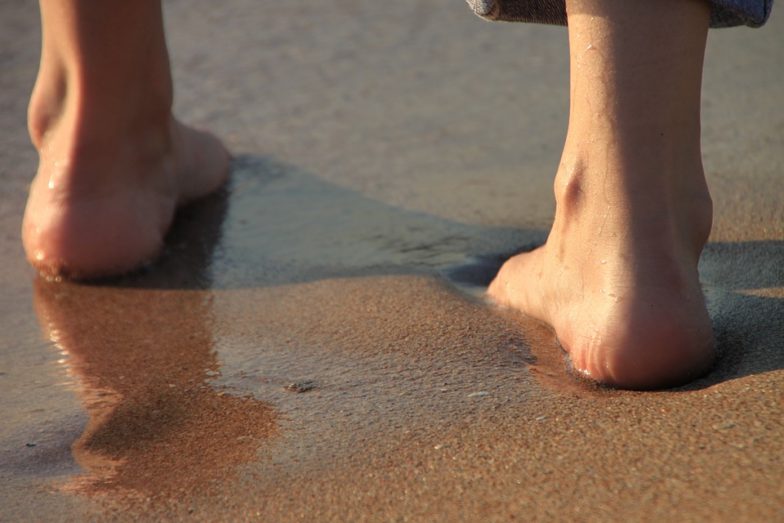It’s recommended for babies and children to walk barefoot as much as possible.
One of the simplest ways to motivate proprioceptive and vestibular development is to let our babies be barefoot. Another benefit to keeping babies barefoot is the encouragement of presence of mind and conscious awareness. As the little pads of babies’ feet feel, move, and balance on the surface that they are exploring, the information sent to the brain from tactile, proprioceptive, and vestibular pathways quiet, or inhibit, other extraneous sensory input. This creates focus and awareness of walking and moving through space; babies get more tuned in to their surroundings.
This is a large part of the reason why some neurologists recommend flat shoes, like swim shoes, for children with certain neurological delays. Wearing shoes with less padding improves the feedback from the feet and helps improve walking in these children.
Wearing shoes prevents proper toe spread, which interferes with the foot’s ability to function properly, and prevents proper movement development, which can make children more susceptible to foot and lower leg injury. Studies show that a barefoot childhood will result in fewer instances of deformed toes, greater foot flexibility, stronger foot muscles, greater agility, better hip circumduction and more flexibility of the gluteal and hamstring muscles.
The benefits of going barefoot are plentiful!
Adults should kick off the shoes too!
Adults who go barefoot have naturally shaped feet, straighter toes, free of corns, hammer toes, bunions and calluses, and well-shaped legs resulting from a natural and balanced gait. Barefoot running and exercise is becoming a growing practice showing better performance, less ankle sprains, less plantar fasciitis and less lower back disc problems due to more of a natural motion and foot awareness. Many top companies are trying to produce shoes that can emulate the bare foot such as Nike “free” and Merrill. Going barefoot, your feet and legs tire less, circulation is better, and endurance is increased. If you have been a shoe person all your life, you will have to start slow to develop all those muscles again. Start by wearing no shoes at home and perhaps going for a walk on the beach. Yoga practise is also great for the feet.
Barefoot Shoes: A Healthy Compromise?
For those who aren’t comfortable with being completely barefoot, new minimalist and barefoot shoes are the best of both worlds. These are also great for everyday use in places where shoes are needed.
Being barefoot is the best when possible. When that isn’t an option, there are some great barefoot shoes that provide almost the same benefits. In general, shoes can be considered “barefoot shoes” if they:
– Do not have a raised heel. The shoe should be flat and all the same thickness from heel to toe.
– Allow free movement of the toes. Many shoes have thin or even pointy toe beds and constrain the toes. A barefoot shoe should be open or allow free toe movement.
In other words, barefoot shoes provide a basic protective barrier between the foot and the ground and not much else. Barefoot shoes also qualify as minimalist shoes, though not all minimalist shoes are technically barefoot shoes.
Recommended Barefoot Shoes
Adults – Vivo Barefoot. For a true barefoot shoe, their Eclipse model is great. Five Fingers is another popular brand.
Babies and Toddlers – Robeez
Thankfully, walking barefoot is a little more socially acceptable before age 2 or so! When going barefoot isn’t allowed, Robeez (or similar) shoes are great. There are many options for kids on the website Happy Little Soles.
If you have any concerns about foot alignment or how this may be affecting your spine, just ask Dr Graeme at the clinic.



